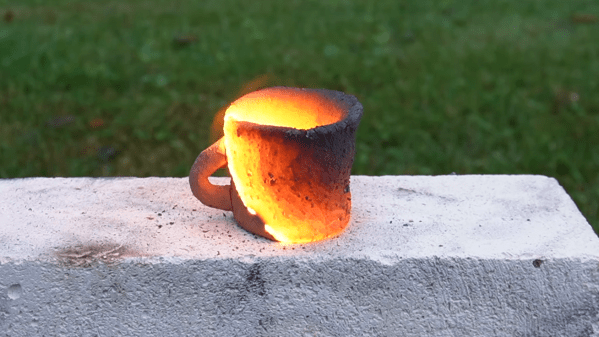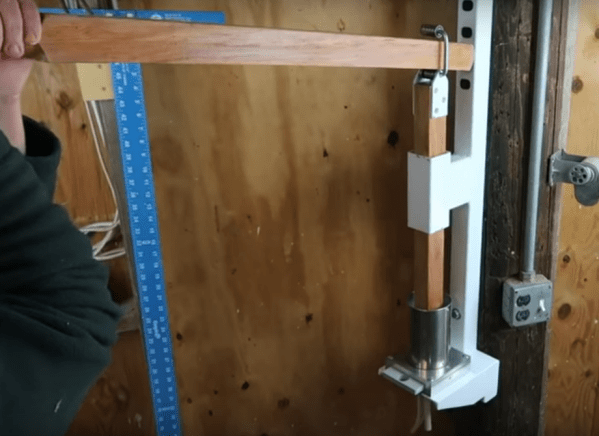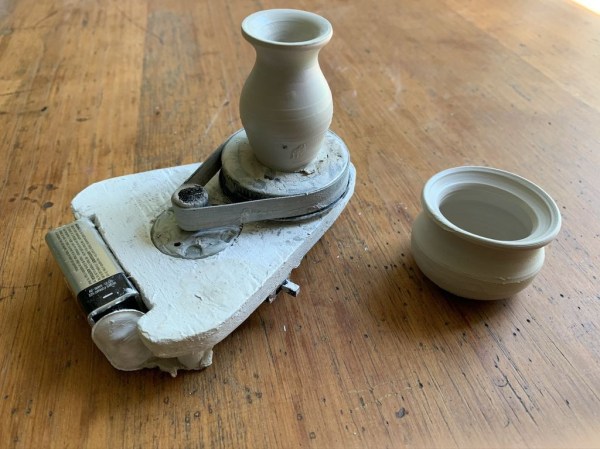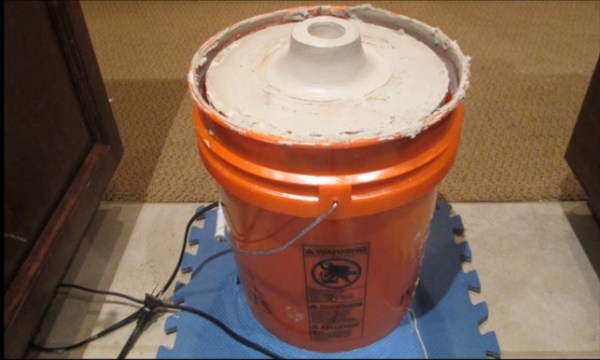Finely powdered aluminium can make almost anything more pyrotechnically interesting, from fireworks to machine shop cleanups – even ceramics, as [Degree of Freedom] discovered. He was experimenting with mixing aluminium powder with various other substances to see whether they could make a thermite-like combination, and found that he could shape a paste of aluminium powder and clay into a form, dry it, and ignite it. After burning, it left behind a hard ceramic material.
[Degree of Freedom] was naturally interested in the possibilities of self-firing clay, so he ran a series of experiments to optimize the composition, and found that a mixture of three parts of aluminium to five parts clay by volume worked best. However, he noticed that bubbles of hydrogen were forming under the surface of the clay, which could cause cracks during the firing. The aluminium was reacting with water to form the bubbles, somewhat like a unwanted form of aerated concrete, and for some reason the kaolinite in clay seemed to accelerate the reaction. Trying to passivate the aluminium by heating it in air or water didn’t prevent the reaction, but [Degree of Freedom] did find that clay extracted from the dirt in his back yard didn’t accelerate it as kaolinite did, and the mixture could dry out without forming bubbles.
This mixture wasn’t totally reliable, so to make it a bit more consistent [Degree of Freedom] added some iron oxide to accelerate the burn through an actual thermite reaction – some mixtures burned hot enough to start to melt the clay. After many tests, he found that sixteen parts clay, seven parts aluminium, and five parts iron oxide gave the best results. He fired two cups made of the mixture, a thin rod, and a cube, with mixed results. The clay expanded a bit during firing, which sometimes produced a rough finish, cracking, and fragility, but in some cases it was surprisingly strong.
The actual chemistry at work in the clay-aluminium mixtures is a bit obscure, but not all thermite reactions need to involve iron oxide, so there might have been some thermite component even in the earlier mixtures. If you need heat rather than ceramic, we’ve also seen a moldable thermite paste extruded from a 3D printer.
pottery5 Articles
Extrusion For The Pottery Shop
Extrusion is a process for forming materials by forcing them through an opening, which can allow for complex shapes. Aluminum extrusion beams are what most of us are probably thinking of, but plenty of other things are made from extruded material like pipe, heat sinks, and even macaroni. Extrusion can also be used for modelling clay to create uniform sections of rounded clay as a starter material for producing other pottery, and [Justins Makery] has built a custom extruder to do just that.
The build starts with welding together a metal frame to hold the press, and uses a wooden wagon handle to drive the extruder. The handle can be moved up or down the frame to increase the range of motion thanks to a custom bearing and slots cut into the frame’s post. The piston mechanism itself is built out of aluminum plate with a cylinder loosely fitted to it to allow for easy cleaning, and the top of the piston uses a loose-fitting plastic cap cut out of an old cutting board.
With everything in pace, the extruder can make cylinders of clay of any desired thickness thanks to swappable dies. While it doesn’t produce the end result of the workshop directly, it definitely helps to provide the potter with clay of uniform dimensions used for building other pieces of pottery, much like how aluminum extrusions are used to build all kinds of other things as well.
Take Pottery For A Spin With A Pocket-Sized Wheel
If 2020 can be remembered in any positive light, it would be that this has been the year of the hobby tryouts. Why not pottery? Sure, throwing pots won’t fill your belly like homemade bread. But we would bet you can see the value in having a bunch of expendable objects that are easily (and quite satisfyingly) smashed to smithereens. The best part is that between the workbench, junk box, and recycle bin, you can probably build [Jadem52]’s pottery wheel for ants with stuff you already have. Bonus!
Pottery wheels aren’t that complicated. They’re honestly kind of expensive for what they are — a motor and a belt driving a rotating platter. It’s like a record player, but less fussy. Where they really get you on expense is the kiln to heat-treat those pots into sturdy vessels. But you could always use air-dry clay, especially if you’re making these things just to smash them whenever you need to let off some steam.
So anyway, you don’t need much more than a motor, a jar lid for a wheel to throw on, and a bearing to make it spin smoothly. Store-bought pottery wheels have a foot feed to control the motor speed, but this pocket version is either spinning on nine volts or it isn’t. The great thing about a project like this is that once you have the general principle down and use the thing, you can iterate and upgrade to your heart’s content. Take it for a little spin after the break.
If you want to hack together a more conventionally-sized wheel, an old ceiling fan motor should be more than sufficient.
Continue reading “Take Pottery For A Spin With A Pocket-Sized Wheel”
Repurposing A Ceiling Fan Into A Pottery Wheel
The wheel goes round and round as does [Lou Wozniak]. He’s come back to us, this time hacking together a pottery wheel from a cheap ceiling fan. This is a great use for a discarded or inexpensive fan and the build should cost less than $50. As you watch the video you learn that repurposing the ceiling fan was no simple feat. Lucky for us [Lou] spins through detailed construction procedures and doesn’t fail to cover every tip and trick. He really does think outside the box or should we say inside the bucket and peanut butter jar. The fan gets dismantled as well as rewired inside a 5 gallon bucket which is used as the pottery wheel housing and stand. A plastic peanut butter jar was used as a makeshift electrical junction box inside the bucket. He remounted the motor’s string operated speed switch on the side of the jar and routed the pull string out the side of the bucket. The fan motor should have three or four switch speed settings which might be enough control. If continuous variable speed control is desired he could add in a controller similar to [Ben Krasnow’s] AC controller using one pin on a microcontroller. UPDATE: [AKA the A] tells us in a comment below that this controller won’t work with a ceiling fan, but we still really like [Ben’s] project so we’re leaving this link here.
Most potters use significant amounts of water to wet the clay while they throw, so we have reservations about having the high voltages and open motor design directly under the wheel with no shielding. We know [Lou] could easily hack in a splash pan and of course always plug into a ground fault protected receptacle when using electrical appliances around water.
We do get to see the wheel in operation at the end of the video, which you can watch after the break. However, [Lou] makes no claims at being a pottery artisan.
Continue reading “Repurposing A Ceiling Fan Into A Pottery Wheel”
Sculpting Clay With Sound
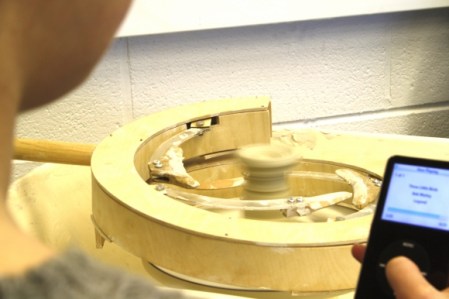
A group of students at the University of Dundee have created this interesting prototype called Sound Sculpted. The goal was to sculpt clay using sound files drive the sculpting arms. Ideally, you would end up with pieces of art that were unique to each piece of music. As you can see in the video (after the break), they did a pretty good job of building this thing and getting the arms to respond to the music. It is almost hypnotizing to watch.
We can’t help but notice that there is a bit of a design issue. Since the 4 arms are fixed vertically, and the clay spins on the same axis they are able to move on, your variation will be very limited. We think this doesn’t detract from the project, but does offer a large area for improvement.
How would you change the sculpting arms or their motion to make each piece more unique?

